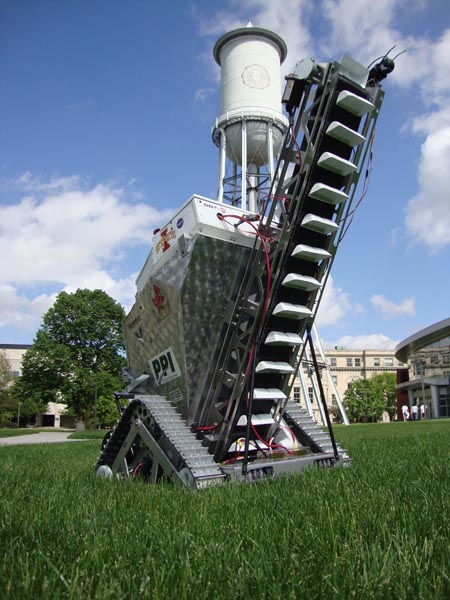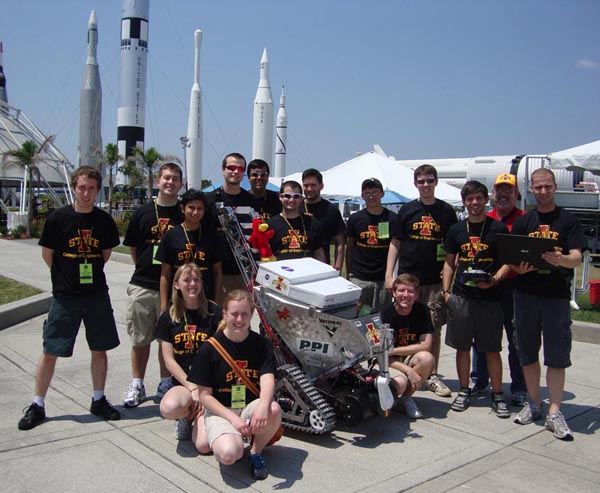![]()
By Rick Hanton, Iowa State Lunabotics Team member and Chairman of SEDS-USA
 On May 21, 2011, two 15-passenger vans trekked 1,400 miles across country from Ames, Iowa, to the Space Coast in Florida. It was a long 26-hour drive for the team of engineers from Iowa State University who had been tirelessly preparing for the trip. As their departure date got closer, many spent every extra waking hour between work and school in the labs of Hoover Hall bending metal, welding steel, drilling holes, and plugging together dozens of circuits—and their 175 pound robot wasn’t even finished yet.
On May 21, 2011, two 15-passenger vans trekked 1,400 miles across country from Ames, Iowa, to the Space Coast in Florida. It was a long 26-hour drive for the team of engineers from Iowa State University who had been tirelessly preparing for the trip. As their departure date got closer, many spent every extra waking hour between work and school in the labs of Hoover Hall bending metal, welding steel, drilling holes, and plugging together dozens of circuits—and their 175 pound robot wasn’t even finished yet.
Welcome to Team LunaCY, Iowa State’s extracurricular club that was participating for the second time in the NASA Lunabotics Mining Competition at the Kennedy Space Center. The competition is open to university teams across the globe, challenging them to design and build lunar rovers able to excavate soil on the moon’s surface via remote control. Because we don’t have a lunar environment here on Earth, the engineers at NASA created a close approximation for the teams at the space center with simulated moon dust, or regolith, inside a giant sandbox called “the LunArena” where the teams compete for recognition and scholarships.
Iowa State’s entry, ART-E II, was one of the few robots at the competition using an impeller to bring regolith into its hopper in the same way that a snow blower would remove snow from your driveway at home. The robot is designed to offload the regolith via a long conveyor belt into NASA’s collection bin located at one end of the LunArena. In competition, the teams had 15 minutes to get as much regolith as possible in the collection bin—a challenging task, as the super-fine, abrasive material clogs gears, binds chains, and can potentially block the operator’s vision when it blows into the air.
In 2010, the year of the competition’s debut, the Iowa State team of mechanical engineering students learned quickly that extra precautions had to be taken when working in a pit of this toxic dust. During their scheduled test run, ART-E quickly stalled when the chains designed to move the track system jammed with regolith, causing a drive motor and speed controller to burn out. The team’s quick fix involved installing another motor and speed controller, plastic chain guards, and some small cleaning brushes—allowing the team to continue to compete that year. Team LunaCY also discovered that the lunar regolith would not go into ART-E’s hopper due to air pressure, so like many teams that year, they did not get any regolith into the collection bin.
This year, Team LunaCY returned with many of last year’s problems removed from the new design. The new tracks used belts, were better designed, and would have no problem in the regolith. The impeller design was improved and the hopper redesigned with vents and vibrators to help the regolith flow into the hopper and out onto the conveyor belt. The electronics and the motors had been moved from the bottom of the robot to the top, making their work easier and keeping them clear of blowing dust. Because much of these design developments were done after classes and homework, they weren’t perfected until just a few weeks before the competition, giving the team only about a month to turn a pile of aluminum, rubber, plastic, and electronics into a working robot.
The group of students did succeed in their endeavor, completing and testing the mechanical assembly just a few days before travelling to Florida. Upon arriving at their hotel in Cocoa Beach, the electronics team kept working through the next few nights to complete all of the robot’s control systems. This included the motors, cameras, and electronics that would allow them to control the robot remotely over a Wi-Fi link. A practice run in the LunArena on Wednesday forced the team to repair a burned out motor caused by a rock jam in the auger housing. Last minute modifications by the mechanical and control teams repaired ART-E II and got him ready to compete. On Wednesday afternoon, the team was forced to relinquish control of the robot until the competition rounds started on Thursday.
The team left the space center feeling satisfied that ART-E II would do his best the next day during his competition round. After a more relaxed night practicing the team’s design presentation rather than grinding excess weight off the robot’s frame (ART-E II weighed in 0.1 kg under the NASA limit), the team felt ready to compete the next morning. Shortly after giving their design presentation, four team members suited up to enter the competition arena and hoisted ART-E II into starting position while the team’s controller prepared his strategy in the dark control van 100 yards away.
At the buzzer, the robot easily rolled out of the starting position on its new tracks and began a series of slow runs back and forth across the sandbox to collect regolith. But after starting its second run, ART-E II became stuck. Eventually the team could see that one of the tracks had popped off its roller bogey after the bogey bolt vibrated out. Driver Mark Wiemer was able to turn in place using his remaining track to pick up more regolith and then went through a dump sequence, dumping approximately 40 kilograms (88 pounds) of regolith back into the sandbox, leaving the NASA judges impressed by the team’s competitiveness and their demonstration of ART-E II’s abilities from a standstill. After continuing its paralyzed digging, the robot lost its other track due to the strain on the drive system and the competition run was done—with no regolith collected.
The Iowa State team was very disappointed in the competition round. The new tracks the team thought were invincible prior to competition ended up being the team’s downfall—a downfall that could have been prevented with a few more quality assurance checks of the machine’s systems. After their run, the team asked if they would be allowed to bring the robot back to the hotel to fix the mechanical problems and prepare for a better demonstration a few days later. NASA judges agreed and said they looked forward seeing ART-E II on Saturday for a demonstration run.
In the demonstration round on Saturday, the Iowa State team once again loaded ART-E II into the LunArena. This time the robot didn’t fail and the tracks amazed the judges and corporate sponsors with their power, speed, and durability. The team managed to collect and dump 14.4 kilograms (over 30 pounds) of regolith in the bin, a qualifying amount, but nothing like the 237 kilograms (522 pounds) collected by the first place team from Laurentian University (Ontario, Canada). The hundreds of pounds of regolith collected by the top teams this year have spurred many of the other teams, including Iowa State, to already begin to rethink and improve their designs to reach even loftier goals next year.
In the end, Team LunaCY won no awards and brought home no money or trophies, but resolved to come back again next year with new systems able to mine faster and more efficiently. The team was also heartened by the judges’ praise of their robot. The NASA judges expressed plans to work on next year’s rules to make it more difficult for those robots that took advantage of the small size of the sandboxes used for the competition (on the moon, similar robots might travel far between regolith collection and deposit locations), but were quite happy with the moon-worthiness of Iowa State’s design.
Next year, ART-E will return with improved electronics and some autonomous capabilities. Team LunaCY plans to compete with a fully tested system that will be truly “lunar capable” and mine more lunar regolith than ever seen before—and who knows, perhaps NASA will want to take their design to the moon someday.
The team wishes to thank their major sponsors who allowed the team to get the parts they needed and compete in Florida this year. The Iowa State LunaCY team was supported by the Iowa State College of Engineering, specifically the mechanical, aerospace, and electrical and computer engineering departments; the Vermeer Corporation; Precision Pulley and Idler; Tsubaki Chain; and the Superior Gearbox Company.